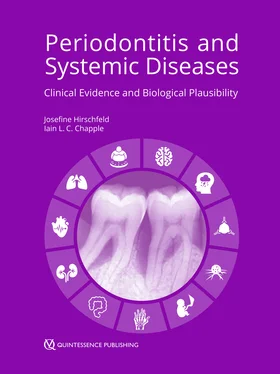The American Diabetes Association suggests that periodontal screening should be considered in overweight or obese adults who have one or more of the following risk factors 223:
● HbA1c ≥ 5.7%, impaired glucose tolerance, impaired fasting glucose on previous testing
● first-degree relative with diabetes
● high-risk race/ethnicity (e.g. African American, Latino, Native American, Asian American, Pacific Islander)
● women who were diagnosed with gestational DM
● history of cardiovascular disease
● hypertension (≥ 140/90 mmHg or on therapy for hypertension)
● HDL cholesterol level < 35 mg/dl and/or a triglyceride level > 250 mg/dl
● women with polycystic ovary syndrome
● physical inactivity
● other clinical conditions associated with insulin resistance (e.g. severe obesity, acanthosis nigricans).
1.5 Conclusion
The interplay between periodontitis and DM has been extensively studied for over 70 years, and with evidence from epidemiological studies and clinical trials, complex interactions between these two distinct pathologies have been demonstrated. Diabetic patients with uncontrolled serum glucose levels are more likely to suffer from periodontitis, compared with well-controlled diabetics and healthy people. At the same time, periodontitis also bears upon the effectiveness of diabetes control. However, improvement of clinical periodontal parameters following standard non-surgical therapy together with effective oral hygiene can be achieved even in people with poorly controlled diabetes. There is also consistent evidence that severe periodontitis affects HbA1c in individuals with and without diabetes. Taken together, moderate to severe periodontitis is associated with an increased risk for the development of diabetes and the existing evidence supports a dose-dependent role for periodontitis and diabetes complications.
Alongside the clinical evidence for this association, studies ventured to understand the biological mechanism that links periodontal condition and diabetes. The effect of T2DM on the inflammatory status of the periodontal tissues is well established. Studies show clearly that hyperglycaemic conditions augment the pro-inflammatory response in the periodontal environment, such as increase of TNF-α, CRP and mediators of oxidative stress. Diabetes affects many biological properties, including cell functions, pro-inflammatory cytokines and alterations in the RANKL/OPG ratio, mediated by hyperglycaemia and AGEs, which accumulate in the periodontal tissues. Weak evidence shows the effect of diabetes on the periodontal microbial composition. Some studies show that periodontal therapy lowers the levels of circulating inflammatory mediators and that this can lead to improved glucose homeostasis. It is important to highlight that some of the published data investigating the mechanistic background linking periodontitis and obesity or DM are very controversial. As a consequence, more human studies are needed to explore the aspect of the bidirectional relationship between periodontal diseases and diabetes, which can contribute to the understanding of the biological mechanisms and the better way to approach these patients in terms of health care. In addition, more animal studies are needed to explore the biological effect of periodontitis on diabetes.
Diabetes requires complex medical care and patients should be asked by physicians whether or not they have seen a dental practitioner in the past year. In addition, physicians should recommend that patients with diabetes have a thorough periodontal evaluation by a dental professional. Finally, the oral health care team has a role to play in identifying both pre-diabetes and undiagnosed DM, and in turn physicians need to be aware of periodontal diseases and their implications in people with diabetes.
1.6 References
1.Lockhart PB, Bolger AF, Papapanou PN, et al. Periodontal disease and atherosclerotic vascular disease: Does the evidence support an independent association?: A scientific statement from the American Heart Association. Circulation 2012;125:2520–2544.
2.Graziani F, Gennai S, Solini A, Petrini M. A systematic review and meta-analysis of epidemiologic observational evidence on the effect of periodontitis on diabetes. An update of the EFP-AAP review. J Clin Periodontol 2018;45: 167–187.
3.Suvan J, D’Aiuto F, Moles DR, Petrie A, Donos N. Association between overweight/obesity and periodontitis in adults. A systematic review. Obes Rev 2011;12:e381–e404.
4.Offenbacher S, Katz V, Fertik G, et al. Periodontal infection as a possible risk factor for preterm low birth weight. J Periodontol 1996;67:1103–1113.
5.Ide M, Papapanou PN. Epidemiology of association between maternal periodontal disease and adverse pregnancy outcomes: systematic review. J Clin Periodontol 2013;40(Suppl 1):S181–S194.
6.American Diabetes Association. Diagnosis and classification of diabetes mellitus. Diabetes Care 2009;32:S62–S67.
7.Deshpande AD, Harris-Hayes M, Schootman M. Epidemiology of diabetes and diabetes-related complications. Phys Ther 2008;88:1254–1264.
8.World Health Organization. WHO Global Health Observatory. World Health Organization (2016). http://apps.who.int/gho/data/view.main.HEALTHEXPCAPARM. Accessed: 12 March 2020.
9.Hruby A, Hu FB. The epidemiology of obesity: a big picture. Pharmacoeconomics 2015;33:673–689.
10.WHO Multicentre Growth Reference Study Group. WHO Child Growth Standards based on length/height, weight and age. Acta Paediatr Suppl 2006;450:76–85.
11.de Onis M, Onyango AW, Borghi E, Siyam A, Nishida C, Siekmann J. Development of a WHO growth reference for school-aged children and adolescents. Bull World Health Organ 2007;85:660–667.
12.Kuczmarski RJ, Ogden CL, Grummer-Strawn LM, et al. CDC growth charts: United States. Adv Data 2000;314:1–27.
13.Carlsson S, Hammar N, Grill V, Kaprio J. Alcohol consumption and the incidence of type 2 diabetes: A 20-year follow-up of the Finnish Twin Cohort Study. Diabetes Care 2003;26:2785–2790.
14.Finkelstein EA, Graham WCK, Malhotra R. Lifetime direct medical costs of childhood obesity. Pediatrics 2014;133: 854–862.
15.Müller-Riemenschneider F, Reinhold T, Berghöfer A, Willich SN. Health-economic burden of obesity in Europe. Eur J Epidemiol 2008;23:499–509.
16.Cawley J, Meyerhoefer C. The medical care costs of obesity: an instrumental variables approach. J Health Econ 2012;31:219–230.
17.Poretsky L (ed). Principles of diabetes mellitus. Boston: Springer-Verlag US, 2010.
18.Einarson TR, Acs A, Ludwig C, Panton UH. Prevalence of cardiovascular disease in type 2 diabetes: a systematic literature review of scientific evidence from across the world in 2007–2017. Cardiovasc Diabetol 2018;17:83.
19.Alberti KG, Eckel RH, Grundy SM, et al. Harmonizing the metabolic syndrome: A joint interim statement of the international diabetes federation task force on epidemiology and prevention; National Heart, Lung, and Blood Institute; American Heart Association; World Heart Federation; International Atherosclerosis Society; and International Association for the Study of Obesity. Circulation 2009;120: 1640–1645.
20.Zimmet PZ, George K, Alberti MM, Shaw JE. Mainstreaming the metabolic syndrome: a definitive definition. Med J Aust 2005;183:175–176.
21.Lorenzo C, Okoloise M, Williams K, Stern MP, Haffner SM. The metabolic syndrome as predictor of type 2 diabetes: the San Antonio heart study. Diabetes Care 2003;26: 3153–3159.
22.Ginsberg HN, MacCallum PR. The obesity, metabolic syndrome, and type 2 diabetes mellitus pandemic: ii. Therapeutic management of atherogenic dyslipidemia. J Clin Hypertens (Greenwich) 2009;11:520–527.
23.Sherwani SI, Khan HA, Ekhzaimy A, Masood A, Sakharkar MK. Significance of HbA1c test in diagnosis and prognosis of diabetic patients. Biomarker Insights 2016;11:95–104.
Читать дальше











![John Bruce - The Lettsomian Lectures on Diseases and Disorders of the Heart and Arteries in Middle and Advanced Life [1900-1901]](/books/749387/john-bruce-the-lettsomian-lectures-on-diseases-and-disorders-of-the-heart-and-arteries-in-middle-and-advanced-life-1900-1901-thumb.webp)
